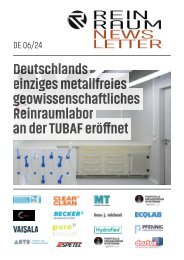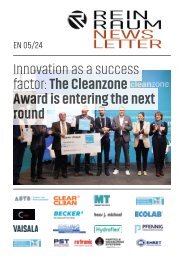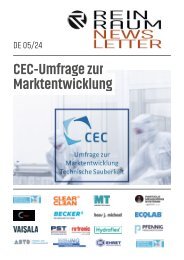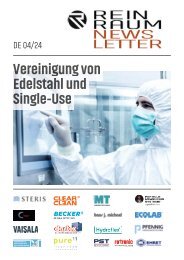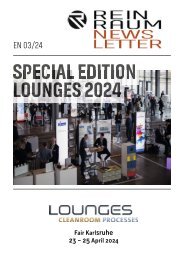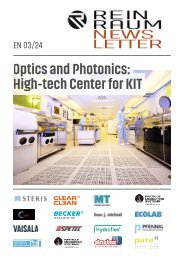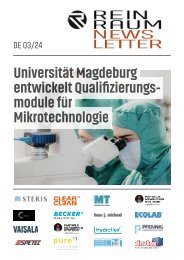Newsletter_12-2022_EN
Fachbeiträge, redaktionelle Beiträge und Veranstaltungen In einer sich schnell entwickelnden Branche sind aktuelle Informationen wichtig. reinraum online bietet einerseits Interessierten die Möglichkeit, sich aktuell und umfassend über die Reinraum-Branche zu informieren. Andererseits können Unternehmen und Personen die Plattform nutzen, Fachbeiträge, redaktionelle Artikel und Firmennews zu veröffentlichen. Ein Veranstaltungskalender ergänzt das Informationsangebot. Der ExpertenPool hilft bei der Profi-Suche: WER macht WAS im Reinraum.
Fachbeiträge, redaktionelle Beiträge und Veranstaltungen
In einer sich schnell entwickelnden Branche sind aktuelle Informationen wichtig. reinraum online bietet einerseits Interessierten die Möglichkeit, sich aktuell und umfassend über die Reinraum-Branche zu informieren. Andererseits können Unternehmen und Personen die Plattform nutzen, Fachbeiträge, redaktionelle Artikel und Firmennews zu veröffentlichen. Ein Veranstaltungskalender ergänzt das Informationsangebot.
Der ExpertenPool hilft bei der Profi-Suche: WER macht WAS im Reinraum.
Create successful ePaper yourself
Turn your PDF publications into a flip-book with our unique Google optimized e-Paper software.
www.reinraum.de<br />
NEWSLETTER<br />
www.cleanroom-online.com Edition <strong>EN</strong> <strong>12</strong>-<strong>2022</strong> | Page 5/42<br />
temperature and time.<br />
Sometimes failures of re-validation can be attributed to using biological<br />
indicators with much higher D-values than those used for the<br />
initial validation (where the biological indicators used for the re-validation<br />
have a far higher resistance compared with those used for the<br />
initial qualification. This could occur, for example, if the initial qualification<br />
was performed using a biological indicator with a D-value of 1.5<br />
minutes and the re-qualification executed using a biological indicator<br />
with a D-value of 3.0 minutes).<br />
Issues can also arise due to changes to load patterns. How load<br />
patterns are assessed such as mass compared with item complexity<br />
and configuration, as with tubing.<br />
One issue will be the requirement to more carefully assess the<br />
quality of pure steam. There is also a materials piece, in that before<br />
any sterilization process is adopted, the suitability for the product or<br />
equipment need to be assessed to make sure it is suitable for the desired<br />
sterilizing conditions.<br />
Another factor is with the design of the load, as I’ve previously<br />
mentioned. Other considerations for the validation design include<br />
handling items of a shape where there is the potential for trapped air<br />
(and thus difficulties with air removal). There are also items that may<br />
not allow steam to penetrate and are thus hard to heat (such as filters,<br />
check valves, and small tubing). Plus, there are items where there is<br />
potential for condensate collection.<br />
It is important to undertaken a careful evaluation, and to set an appropriate<br />
maximum reprocessing time.<br />
Conclusions<br />
We would like to conclude this interview with a quote from the new<br />
Annex 1.<br />
§8.60 The items to be sterilized, other than products in sealed containers,<br />
should be dry, wrapped in a material which allows removal<br />
of air and penetration of steam and prevents recontamination after<br />
sterilization. All loaded items should be dry upon removal from the<br />
sterilizer. Load dryness should be confirmed by visual inspection as a<br />
part of the sterilization process acceptance.<br />
The choice of packaging systems becomes of utmost importance<br />
for proper alignment with the requirements of the new Annex 1. Indeed,<br />
as is clear from the text, and from the interview with Tim Sandle<br />
himself, the success of the sterilization cycle depends on several factors<br />
closely related to the selection of the packaging material: only a<br />
low degree of particle release, an anti-microbial barrier of maximum<br />
effectiveness, a bill that allows uniform steam penetration, and last<br />
but not least tear and puncture resistance can ensure a proper autoclave<br />
cycle.<br />
Critical issues of washable products<br />
How do you evaluate the use of washable products and what,<br />
if any, critical issues do you see in this type of choice?<br />
The key issue with washable products is with the number of times<br />
they can be processed and what the impact of this is upon the life-time<br />
of the item. Integrity issues and release of particles are two areas<br />
of concern, along with other forms of structural weaknesses and discoloration.<br />
This relates not only to the washing process but also to<br />
sterilization – both are aggressive processes that can affect the material.<br />
The choice of water and the type of sterilization process and the<br />
parameters surrounding this represent important choices to be made,<br />
in order to avoid damage and to extend the reprocessing cycle.<br />
AM INSTRUM<strong>EN</strong>TS<br />
Via Isonzo, 1/C<br />
IT 208<strong>12</strong> Limbiate (MB)<br />
Phone: +39 02 8728421<br />
email: info@aminstruments.com<br />
Internet: https://global.aminstruments.com/<br />
Dr. Tim Sandle is a pharmaceutical microbiologist, science writer and<br />
journalist. He is a chartered biologist and holds a first class honours<br />
degree in Applied Biology; a Masters degree in education; and has a<br />
doctorate from Keele University.<br />
Interview by Cristina Masciola, AM Instruments<br />
– Marketing & Communication Manager









